| |
|
|
| |
The time for Browns.
Fri 4th April, 2014
|
|
|
|
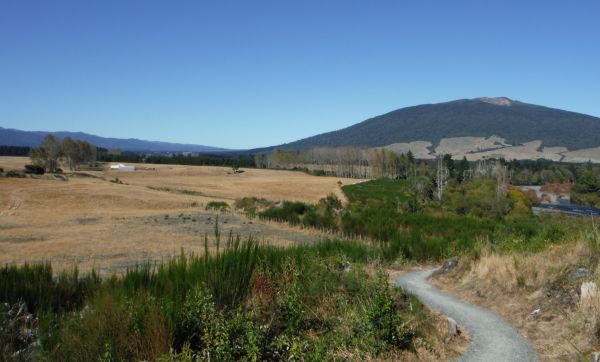
The Tongariro remains low and clear as high pressure over New Zealand continues to dominate the weather patterns. It isn't quite as bad as it was this time last year but with no meaningful rainfall for months its looking very dry and brown out there.
Glancing back at the reports for April 2013 it was a very similar set of circumstances and of course just like then the fishing becomes more difficult the longer it goes on ... especially at this time of year when most of the fish are back in the lake.
Its the same story in early autumn most years and although there are a few showers forecast next week we probably won't get any proper rain until the latter half of the month. There ... that should do the trick ... it'll pour down tomorrow now that I've said that!
Wherever I happened to be on the river this week there were reminders of how quickly the "fishing year" goes by. As I walked passed some of the larger trees I noticed dozens of discarded cicada husks still maintaining their lifeless grip on the trunks ... its hard to believe it was almost three months ago that they first started chirping and we were all looking forward to "cicada time".
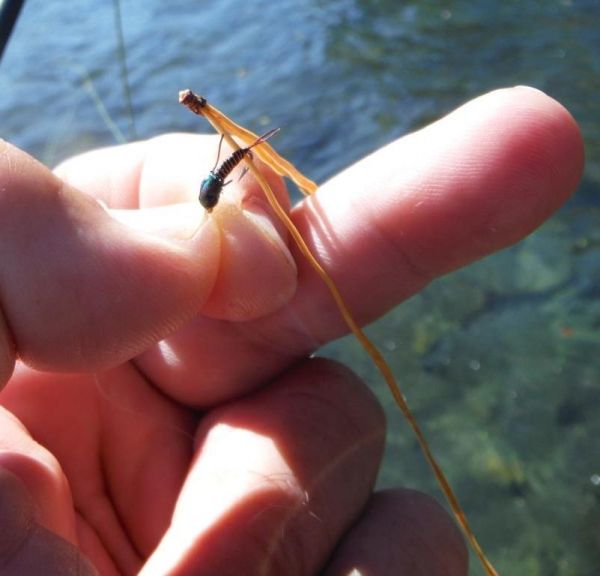 Its nearly a year ago that I wrote "there's a much more autumnal feel along the river" and despite the summer like conditions the access tracks are already framed by an ever thickening carpet of reds and browns as the first of the deciduous trees begin to shut down again for winter. Its nearly a year ago that I wrote "there's a much more autumnal feel along the river" and despite the summer like conditions the access tracks are already framed by an ever thickening carpet of reds and browns as the first of the deciduous trees begin to shut down again for winter.
Unlike deciduous trees pines don't shed all their leaves each fall but at the moment wherever you cast a line on the Tongariro you'll inevitably hook up on some pine needles. These are the equivalent of pine tree "leaves" and every time you get a breeze through the branches you'll see hundreds of the older, browner needles "helicopter" into the river.
They're just another reminder that we're well into autumn and before we know it this years much anticipated winter runs will be underway.
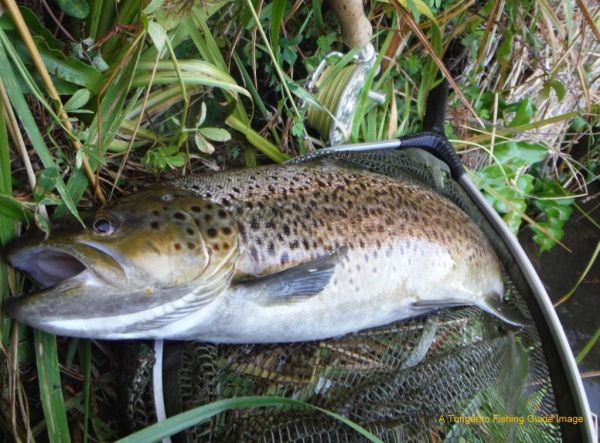
Its these tens of thousands of spawning rainbows that enter the feeder streams and rivers of lake Taupo that the area is famous for. But as the weather warms up the browns begin their spawning migration and for several months anglers have at least a chance of catching that fish of a lifetime.
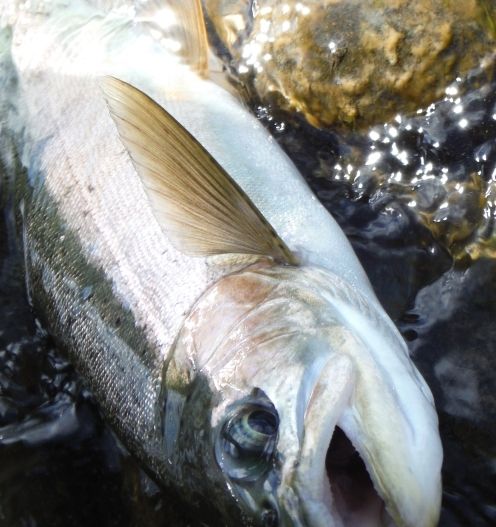
The tough conditions recently have put a lot of anglers off fishing the Tongariro ... and Sunday the river seemed deserted ... I don't think I've ever seen so few rods on the water.
But with such little angling pressure you obviously have a far better chance of getting into some undisturbed stretches, which in turn increases the possibility of you finding a brown or two that hasn't been covered.
Brown seems to be the theme running through this report and at the start of the week when good rainbows were a bit scarce I decided to target browns instead.
Compared to other countries some of the trout in New Zealand waterways are indeed monsters and its no secret that during summer and autumn the Tongariro is home to some very large brown trout ... double figure fish are caught every year.
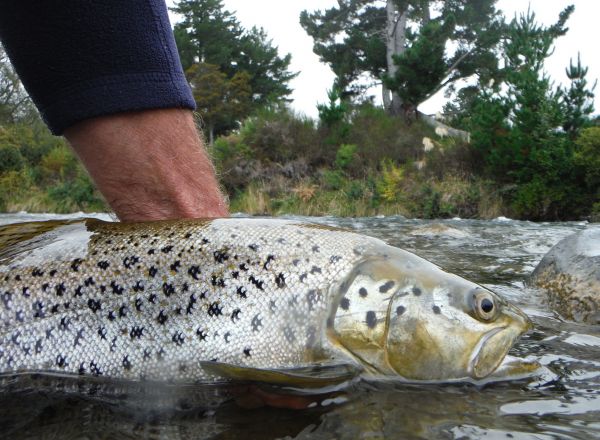
Anglers who consistently catch brown trout on the Tongariro don't usually do so by accident.
They have a good local knowledge of the river and know where, when and how to give themselves the best chance of hooking up.
Depending on the conditions and time of year its possible to catch browns on all of the methods in common use on the Tongariro and everyone has their favorite.
Some are caught after a long hike downriver in daylight, others just a few meters from the road bridge after dark and the furthest upriver I've seen them caught is near the Blue Pool.
But a lot of visiting anglers don't have time to spend hours yomping downriver and if you're with the family I bet Mrs Joe Bloggs won't be too happy about you fishing half the night either. So how do you give yourself a fighting chance of hooking a good brown if you're pushed for time.
Well ... first of all concentrate your efforts between the town pools and Red Hut ... Jeeees! ... thanks a bunch I here you say ... that cuts it down!
If you've been fishing a little while you'll know by now that not all parts of a river routinely contain fish. If you're an upstream nymphomaniac like me as you work through a stretch you'll be constantly scanning the water ahead for likely fish holding spots and more often than not sub-consciously rejecting a lot of it. Reading water. So already a fair chunk of that stretch between town and Red Hut has been eliminated ... you can fine tune your choice and narrow it down even more.
There are studies that show browns prefer an average depth of about twenty five inches when feeding ... I must stress that's an average depth ... and half that depth when actually spawning.
Like rainbows they also tend to seek out faster well oxygenated water to spawn and the same study mentioned a mean velocity of 31.7 cubic meters per second. Spawning aside the rest of the time browns prefer water with a mean velocity of around 26 cubic meters per second and are usually found in slower parts of a suitable stretch off to the side rather than in the main current, or where a rock, log or some sort of structure disturbs the rivers flow and affords them some shelter.
Unlike rainbows they won't stay in fast water for long periods ... even if they're spooked into it.
I generally ignore most but not all of the more popular pools. Places like Admirals, Cattle Rustlers or Duchess have lookouts above them and you'll often easily spot big browns lying in the depths.
But even if you are tempted to have a go at them a combination of variable surface currents and underwater hydraulics make it extremely difficult to present a fly convincingly ... unless you're a pretty skilled angler. It also pays to remember the deeper they are in the water the better their view of the outside world and if you can see them its a fair bet they can see you... so whats left.
Look for water like this ... it can be found at the head of some pools or in the runs between pools.
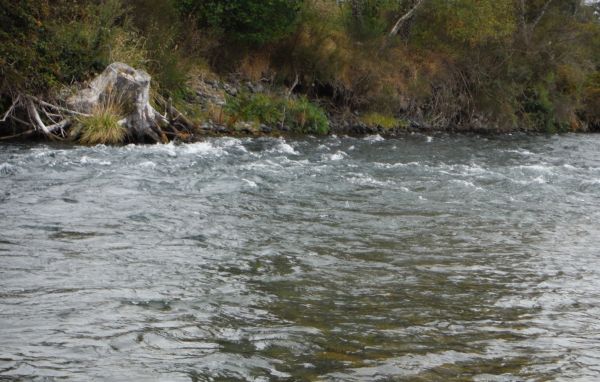 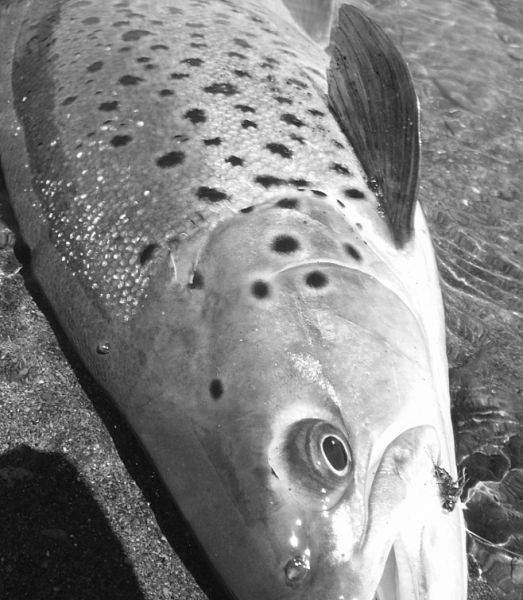
Most of the browns I've ever hooked in the Tongariro have come from from places like the one pictured above. But both browns and rainbows will be found along the seam line that separates the fast and slow water. The river here is less than four feet deep and whenever I nymph this type of water my preference is the long dry and dropper. All of the browns pictured were caught using it in very similar looking water but in different parts of the river.
So whats the best time of day to catch a brown trout on the Tongariro.
Well ... we're all familiar with the old guideline "that fish bite best at times of changing light" and this is generally good advice.
I can only tell you what I've experienced ... ninety per cent of the ones I've caught have been between 11.00 am and 2.00 pm
May be I only catch the lazy ones!
For several days a DOC maintenance crew has been busy cutting back the broom and gorse encroaching on the track above the TRB of the Island Pool and Judges.
This is a favorite route for walkers and cyclists because when you reach the top it gives you some of the best views around of Turangi and the lake beyond and is a great vantage point for those who need photographs of the river and surrounding countryside.
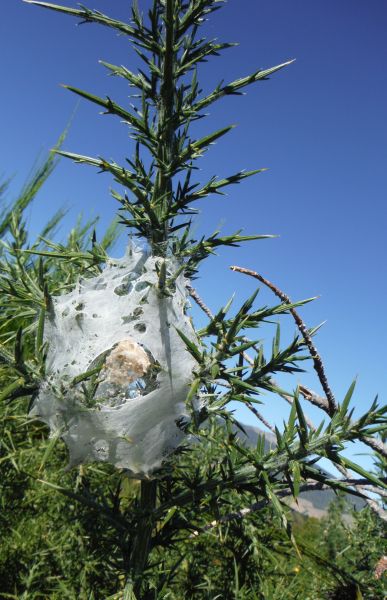
Its also a regular beat for Blue if he hasn't had his daily fishing fix and as we walked him past a newly cleared section of track Gail pointed these out to me.
They're the nests of Nursery spiders and belong to a group commonly called hunting spiders. Unlike many others of their kind they don't spin a web to trap their prey but hunt them down on foot ... all eight of them.
During mating the male will sometimes bribe the female with food so that he can have his wicked way and then leg it before she sinks her fangs into him ... now where have I heard that before?
She'll then carry the egg cluster around with her and just before they hatch construct the nursery leaving the egg mass inside.
Like any good mum she'll stay close by and guard the nest until her babies hatch.
When they're ready the spider-lings leave the nursery and climb to the top of the stem where they produce a small amount of silk which catches any breeze and carries them away.
Its known as ballooning and on on windy days they can travel several kilometers like this.
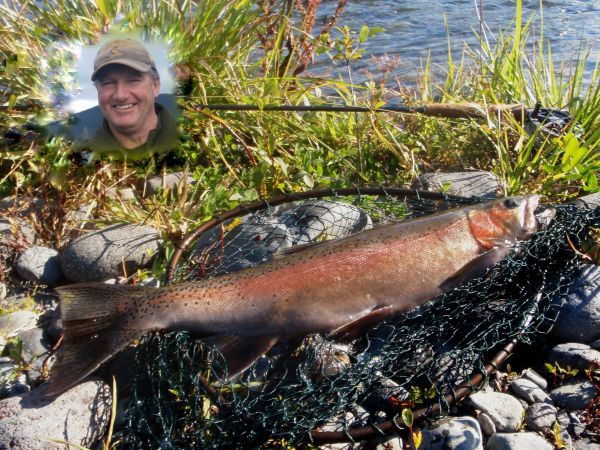
Cambridge angler Mark Tomsett has to travel a little bit further than a few kilometers when he fishes the Tongariro but it looks as if this weeks trip was well worth it. I've had to censor his report a little bit because his language is worse than my wife's ... ouch! Mark continues:
" All the usual places produced. The jack below jumped up for the dry out of the head of the bypass run just below Judges. Bugger all water to hide in! but it took Stu's hi-vis cicada a small pattern that I could still see !!
It wasn't as big as last nights fish out of the Bain. That took "Marcels caddis pupae" under the dry, great fight I think we were both knackered in the end .He's smoking now!
I hooked another jack under the willows above Judges and a couple of small hens out of the riffles between the bridge and Judges and also caught a couple in the head of the pool.
Plenty of Tongariro sprats to keep me awake as well.
Most of them took a small green caddis as the point fly, I'd changed to this after the first one hit Marcels caddis pupae.
Not bad out of a river they said was too low, too clear, too hard ... fish the lake they said !!
I enjoy the walk as much as the fishing so I'm quite happy "
Cheers
Mark
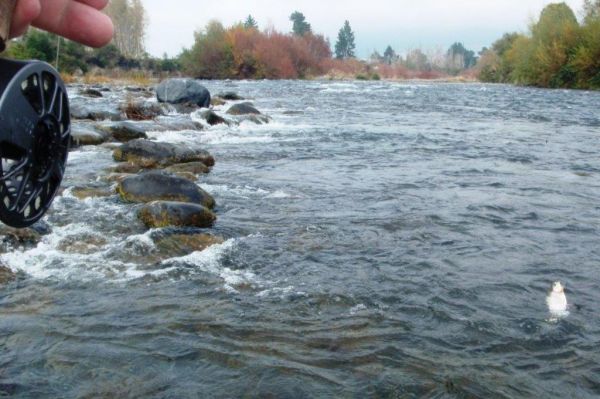 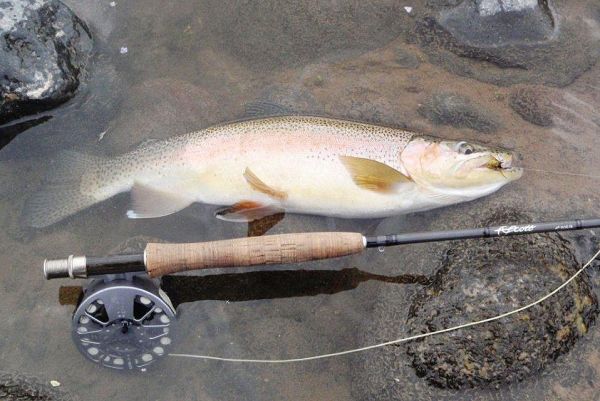
Thanks big fella
and
Tight lines guys
Mike |
|
|
| Back to Top |
|
|
|
|
|
|
|